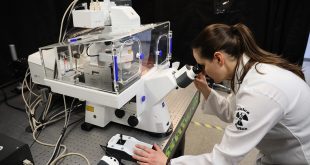At the University of British Columbia, there’s a study that offers new evidence that protected natural areas promote mammal diversity. Researchers at UBC’s Faculty of Forestry analyzed data from a global data set drawing from 8,671 camera trap stations spanning four continents, the largest number of wildlife cameras ever analyzed in a single study.
They found more mammal diversity in survey areas where habitat had a protected designation compared to forests and other wilderness areas that lacked that designation. This was true even when these protected areas experienced human disturbances, such as recreational use and logging.
“As international discussions continue on new global targets for expanding protected areas, it’s important to be able to measure the benefits of the protections that do currently exist,” said Cole Burton, the study’s senior author and a conservation biologist who researches mammal populations and human-wildlife coexistence. “Under the Convention on Biological Diversity, the world is currently discussing new targets for how much of the Earth’s surface should be covered by parks. We need to have better information to inform these policy discussions.”
Watching from above, drones help UBC researchers study killer whales
Meanwhile, along Canada’s West Coast, drones are being used by researchers at UBC’s Hakai Institute in the northern and southern waters of Vancouver Island, where they gathered stunning new aerial and underwater footage of Northern and Southern Resident killer whales that offers a new glimpse into the underwater lives of these whales. The project is looking into whether endangered southern resident killer whales are getting enough of their preferred prey, Chinook salmon, to meet their nutritional needs. The researchers used aerial drones and underwater cameras with biologgers to study their feeding behaviour, and hydrophones to measure prey availability.
Lead investigator Andrew Trites from UBC’s Institute for Oceans and Fisheries, explains: “Looking at the drone footage we collected on our research voyage last year, one of the things that struck us was the extent to which resident killer whales touched each other. This year, we were able see this touching from their perspective. In one instance, we got to see a northern resident whale calf getting its belly rubbed by its mother’s pectoral fin as they swam side by side. It was something nobody could see if they were watching killer whales from a boat.”
Migratory patterns of marine life
Migratory patterns among ocean animals have captured the attention of seafarers long before marine biology became a thing. The Ocean Tracking Network (OTN), headquartered at Dalhousie University in Halifax, is contributing to a deeper understanding of ocean life through the use of autonomous marine vehicles and fixed-station telemetry, and oceanographic equipment like acoustic tracking. OTN has deployed more than 2,000 Canadian-made acoustic receivers and monitors that send signals to floating buoys or fixed locations in the ocean around the world to track the movements of 130 commercially, ecologically and culturally valuable aquatic species.
These technologies enable scientists to see the world through the eyes of an animal. Last fall, a team from UBC’s Marine Mammal Research Unit spent a month at sea, filming both Northern and Southern resident killer whales, not only from above with drones, but also from below, by placing suction-cup camera tags onto the whales’ bodies. These devices allowed the crew to record what the whales see and hear and the sounds they make, as well as their three-dimensional movements, diving depths and feeding behaviours.
“With this technology we’re able to combine all the different data streams to get a complete picture of what is going on underwater. We’ve never been able to do that before. It’s quite thrilling,” says Sarah Fortune, a post-doc marine biologist, who designed the study.
Investing in new tech to monitor the elusive Canada lynx
At the Integrative Wildlife Conservation lab at Trent University in Peterborough, Ont., scientists are keeping close tabs on the Canada lynx in the Yukon. Launched in the 1980s, it’s the longest-running study of a vertebrate predator-prey system in Canada, and it recently secured a $149,000 grant from the Natural Sciences and Engineering Research Council of Canada for additional tracking devices that will help them get a deeper look at how the animals respond to drastic changes in their environment.
The new state-of-the-art instruments attached to the lynx include satellite GPS radio-collars for tracking movement and habitat selection, accelerometers for identifying activity patterns, and acoustic recorders for tracking interactions with both prey and other predators. The wildcats are harvested for their fur and while their populations are secure in central Canada, more southerly populations are of conservation concern.
Butterflies and songbirds
At the University of Guelph, since 2008 Ryan Norris’s lab has been working on migration patterns and population dynamics of monarch butterflies as well as many other migratory animals.
The team primarily uses stable isotopes in wing chitin to estimate the natal origin of individuals captured throughout the range and over multiple seasons, explains Norris. Chitlin from monarch butterfly wings has been used to analyze strontium in the wing. It’s an indicator for migration patterns when correlated with local soils and vegetation. Similar to other organisms, nitrogen and carbon isotopes can also be used to reconstruct the animal’s diet.
The researchers aim to describe broad-scale connectivity patterns across the eastern breeding range and then integrate this information into year-round predictive population models to understand what limits and regulates migratory monarch butterflies.
Norris’s team is also tracking songbirds. Advancements in nanotechnology have revolutionized the study of bird migration, offering smaller tracking devices like the light level geolocators that are replacing heavier satellite telemetry tags and bird banding. It has also enabled the Norris lab to shed light on how the tiny blackpoll warbler, one of Canada’s fastest declining songbirds, makes its way to Venezuela in the winter, on a 10,000-kilometre migratory path.
Genomics and tracking data deepen our understanding of the endangered right whale
Marine biologists like Timothy Frasier of Saint Mary’s University in Halifax have teamed with American researchers at Boston’s New England Aquarium to apply genomics as they study the world’s most endangered large whale, the North Atlantic right whale. They are using genomic data to improve conservation strategies for this endangered species, of which there are fewer than 400 individuals remaining.
Frasier explains, “Although inbreeding has been an important topic in population biology for over a century, our understanding of its impact in the wild, and in endangered species in particular, is still in its infancy due to a lack of good case studies. This study, where we have the ability to combine 40 years of field data with genomic data for such a high percentage of individuals, will allow us to not only quantify the impacts of inbreeding on the recovery potential of this species, but will also greatly improve our understanding of the impacts of inbreeding on wildlife populations and the subsequent implications for conservation.”
From genetics to game changing satellite technologies like Canada’s RADARSAT, a satellite network that monitors oceans, ice and Earth’s ecosystems, scientists across the country are harnessing the power of technology to gain a deeper understanding of the world around us and are standing on guard to protect life on the planet.
 BioLab Business Magazine Together, we reach farther into the Canadian Science community
BioLab Business Magazine Together, we reach farther into the Canadian Science community





